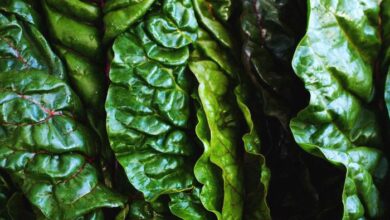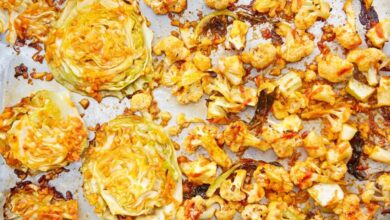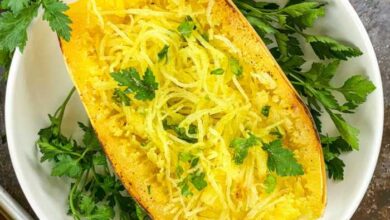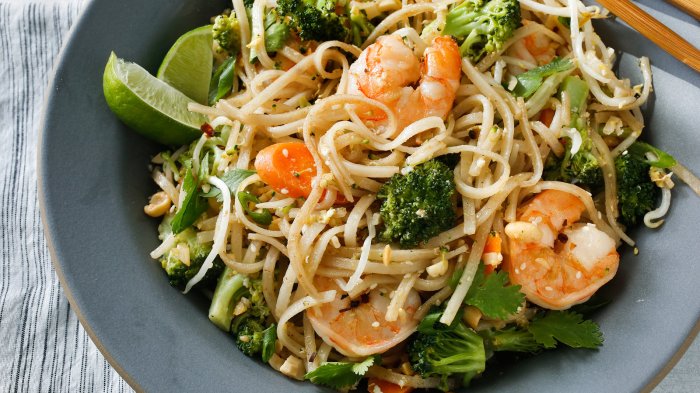
Easy Shrimp Pad Thai: A Deliciously Simple Recipe – Craving the vibrant flavors of Thailand without the fuss? Look no further! This recipe takes the classic dish and simplifies it for even the most novice cooks. Forget about complicated techniques and endless ingredients – this version is all about quick and easy steps, resulting in a dish that’s just as flavorful as the restaurant version.
The key to a great Pad Thai lies in the balance of sweet, savory, and tangy flavors. Think of it as a symphony of tastes: the noodles provide a chewy base, the shrimp brings a touch of umami, and the sauce, a blend of fish sauce, lime juice, and sugar, ties everything together.
This dish is a perfect blend of textures, too, with the soft noodles contrasting against the crispy shrimp and crunchy peanuts.
Shrimp Pad Thai: A Culinary Delight: Easy Shrimp Pad Thai
Shrimp pad thai is a beloved Thai noodle dish that has captured hearts and taste buds worldwide. Its irresistible combination of savory, sweet, and tangy flavors makes it a true culinary delight. This dish is renowned for its simple yet flavorful ingredients and its ease of preparation.
Whether you’re a seasoned cook or a culinary novice, whipping up a delicious shrimp pad thai at home is achievable.
Key Ingredients and Flavors
The key ingredients in shrimp pad thai are what create its signature taste. These include:
- Rice noodles:These noodles provide the base for the dish, absorbing the delicious sauce and offering a chewy texture.
- Shrimp:Fresh or frozen shrimp adds a delicate sweetness and protein to the dish.
- Fish sauce:This fermented fish sauce provides a salty, umami depth to the flavors.
- Tamarind juice:Tamarind juice adds a tangy and slightly sweet element to the dish, balancing out the savory flavors.
- Palm sugar:This natural sweetener provides a subtle sweetness that complements the other ingredients.
- Garlic and chilies:These aromatics add a pungent and spicy kick to the dish.
- Bean sprouts:Bean sprouts add a refreshing crunch and a touch of bitterness to the dish.
- Crushed peanuts:Toasted peanuts provide a nutty flavor and a satisfying crunch.
- Lime juice:A squeeze of lime juice adds a bright and acidic note that balances the richness of the dish.
The combination of these ingredients creates a symphony of flavors that is both satisfying and complex. The savory notes of the fish sauce and garlic are balanced by the sweetness of the palm sugar and tamarind juice. The spicy kick of the chilies adds a layer of heat, while the refreshing crunch of the bean sprouts and peanuts provides textural contrast.
Recipe Variations
The beauty of Pad Thai lies in its adaptability. While the basic recipe is delicious, you can easily customize it to your taste and dietary needs. This section explores several variations of the shrimp pad thai recipe, highlighting the “easy” aspect of the dish.
Noodle Preparation Methods, Easy shrimp pad thai
The choice of noodles is a key element in the Pad Thai experience. Here’s a comparison of different methods for preparing the noodles:
- Soaking:The traditional method involves soaking the rice noodles in hot water until they soften. This technique is time-consuming, requiring approximately 30 minutes. It is important to ensure that the noodles are fully submerged in the water and not left to sit in the air, as this can lead to a tough texture.
- Boiling:For a faster method, you can boil the rice noodles in water for about 2-3 minutes until they become pliable. This technique offers a more convenient option for those who prefer a quicker preparation. However, overcooking the noodles can lead to a mushy texture, so it’s crucial to monitor the cooking time carefully.
- Pre-cooked Noodles:Many grocery stores now offer pre-cooked rice noodles, which can be used directly in the Pad Thai. This option is incredibly convenient, requiring no additional preparation time. However, the texture of pre-cooked noodles may differ from those prepared from scratch, potentially affecting the overall taste and experience.
Shrimp Preparation
Shrimp is a popular protein choice for Pad Thai, and different methods can be used to prepare it:
- Pan-frying:This is the most common method for preparing shrimp in Pad Thai. Simply heat some oil in a pan and sauté the shrimp until they turn pink and opaque. This technique offers a crispy texture and enhances the flavor of the shrimp.
- Stir-frying:Similar to pan-frying, stir-frying the shrimp in a wok with a little oil and garlic can add a unique flavor profile to the dish. This method is suitable for a larger batch of shrimp and can be easily incorporated into the overall stir-frying process of the Pad Thai.
Easy shrimp pad thai is a quick and satisfying weeknight dinner, and it’s always a crowd-pleaser. The vibrant flavors and textures of the dish are a feast for the senses, and the simple preparation makes it a great choice for even the busiest cooks.
Speaking of vibrant, have you ever considered adding a splash of personality to your home with a statement wall? You can create a truly unique and eye-catching feature by using paint pens to create your own design, just like the ones featured in this article on making a statement wall with paint pens.
Once your wall is finished, you’ll be ready to enjoy your delicious shrimp pad thai in a space that reflects your own personal style.
- Pre-cooked Shrimp:For convenience, you can use pre-cooked shrimp, which are readily available at most grocery stores. This option eliminates the need for additional cooking time, making it an ideal choice for busy weeknights. However, the texture and flavor of pre-cooked shrimp may vary depending on the brand and preparation method.
Sauce Variations
The sauce is the heart of Pad Thai, and several variations can be explored:
- Traditional:The classic Pad Thai sauce is made with tamarind paste, fish sauce, palm sugar, and chili flakes. This combination offers a balance of sweet, sour, salty, and spicy flavors that are characteristic of the dish.
- Vegan:For a vegan alternative, replace fish sauce with soy sauce or tamari. You can also substitute palm sugar with brown sugar or agave nectar. To enhance the flavor, consider adding a dash of lime juice or a pinch of smoked paprika.
- Sweet and Spicy:For a sweeter and spicier version, add more palm sugar and chili flakes to the sauce. You can also incorporate a tablespoon of sriracha or a pinch of cayenne pepper for an extra kick.
Vegetable Options
Pad Thai is typically made with bean sprouts, chives, and tofu. However, you can easily experiment with other vegetables:
- Green Vegetables:Add a handful of spinach, bok choy, or broccoli florets to the dish for a boost of nutrients and color. These vegetables can be added towards the end of cooking to ensure they retain their vibrant green hue.
- Bell Peppers:For a vibrant and flavorful addition, incorporate sliced bell peppers into the Pad Thai. Choose from red, yellow, or green bell peppers, or mix them for a colorful and flavorful experience.
- Mushrooms:Shiitake, oyster, or button mushrooms can be added to the dish for a savory and earthy flavor. Slice the mushrooms thinly and add them towards the end of cooking to prevent them from becoming too soft.
Protein Alternatives
While shrimp is a common protein in Pad Thai, other options can be used:
- Chicken:Marinated chicken strips or cubes can be stir-fried and added to the Pad Thai for a delicious and satisfying meal. The chicken can be seasoned with soy sauce, garlic, and ginger for a flavorful experience.
- Tofu:Firm tofu can be pressed and cubed to create a meaty texture in the Pad Thai. Marinate the tofu in a mixture of soy sauce, ginger, and garlic before stir-frying it for a flavorful and protein-rich addition.
- Vegetables:For a vegetarian option, you can create a Pad Thai with a variety of vegetables, such as broccoli, carrots, bell peppers, and mushrooms. This version is packed with nutrients and offers a satisfying vegetarian meal.
Cooking Techniques

The art of making Pad Thai lies in the balance of flavors and textures. This section delves into the essential steps and techniques to achieve a delicious and authentic Pad Thai experience.
Preparing the Ingredients
Proper preparation of ingredients is crucial for a successful Pad Thai. This ensures optimal flavor and texture in the final dish.
- Shrimp Preparation:Fresh or frozen shrimp should be peeled and deveined. Marinate them in a mixture of soy sauce, fish sauce, and cornstarch for about 15 minutes. This tenderizes the shrimp and adds a depth of flavor.
- Noodles:Soak rice noodles in warm water for about 10-15 minutes, until they are pliable. Drain them thoroughly and set them aside.
- Vegetables:Thinly slice the vegetables, such as bean sprouts, garlic, and scallions.
- Tofu:Cut tofu into small cubes and press them to remove excess moisture.
- Sauce:Combine all the ingredients for the Pad Thai sauce, including fish sauce, soy sauce, sugar, lime juice, and chili flakes, in a small bowl. Whisk them together until the sugar dissolves.
Cooking the Pad Thai
The cooking process is quick and requires focused attention to achieve the perfect balance of flavors and textures.
- Heat the Oil:Heat a large wok or frying pan over medium-high heat. Add a generous amount of oil, enough to coat the bottom of the pan.
- Sauté the Shrimp:Add the marinated shrimp to the hot oil and stir-fry until they turn pink and opaque, about 2-3 minutes. Remove the shrimp and set them aside.
- Sauté the Vegetables:Add the garlic and scallions to the wok and stir-fry for a minute, until fragrant. Then, add the bean sprouts and stir-fry for another minute.
- Add the Noodles:Add the soaked rice noodles to the wok and toss them with the vegetables, ensuring they are well coated in the oil.
- Add the Sauce:Pour the prepared Pad Thai sauce over the noodles and vegetables, stirring continuously to evenly distribute the sauce.
- Cook the Noodles:Continue to stir-fry the noodles for about 2-3 minutes, until they are heated through and the sauce has thickened slightly.
- Add the Shrimp:Return the cooked shrimp to the wok and stir-fry for a final minute, to combine all the ingredients.
- Serve:Transfer the Pad Thai to a serving dish and garnish with chopped peanuts, coriander, and a squeeze of lime juice.
Visual Guide
| Step 1: Gather all ingredients. | |
| Step 2: Marinate the shrimp in soy sauce, fish sauce, and cornstarch. | |
| Step 3: Soak rice noodles in warm water until pliable. | |
| Step 4: Sauté shrimp until pink and opaque. | |
| Step 5: Sauté garlic and scallions, followed by bean sprouts. | |
| Step 6: Add soaked rice noodles to the wok and toss with vegetables. | |
| Step 7: Pour the prepared Pad Thai sauce over the noodles and vegetables. | |
| Step 8: Stir-fry the noodles for 2-3 minutes, until heated through. | |
| Step 9: Return the cooked shrimp to the wok and stir-fry for a final minute. | |
| Step 10: Serve the Pad Thai garnished with peanuts, coriander, and a squeeze of lime juice. |
Tips and Tricks
Mastering the art of making shrimp pad thai goes beyond simply following a recipe. There are several tips and tricks that can elevate your dish to new heights, ensuring that your pad thai is not only delicious but also visually appealing.
Texture and Flavor
Achieving the perfect texture and flavor in your shrimp pad thai requires a balance of elements. The noodles should be cooked al dente, with a slight bite, while the sauce should be flavorful and slightly sweet.
I’m all about quick and easy meals, and shrimp pad thai is definitely a winner in that category. It’s so simple to throw together, and the flavors are always amazing. Speaking of simple and amazing, I recently tackled a project that felt equally rewarding: how I organized my hall closet in one afternoon.
The feeling of accomplishment from that project is still lingering, and it’s a reminder that even small tasks can make a big difference. Now, back to that shrimp pad thai – I think I’ll whip up a batch for dinner tonight!
- Use high-quality ingredients: Fresh, flavorful ingredients are crucial for a truly delicious pad thai. Opt for fresh, plump shrimp, and use high-quality rice noodles. The quality of your ingredients directly impacts the final taste.
- Don’t overcook the noodles: Overcooked noodles will become mushy and lose their texture. Cook them according to the package instructions, aiming for an al dente consistency.
- Season generously: Don’t be afraid to use plenty of fish sauce, soy sauce, and sugar to achieve a flavorful and balanced sauce.
- Add a touch of acidity: A squeeze of lime juice or a splash of vinegar can help balance the sweetness of the sauce and add a refreshing element.
- Use a good quality wok: A wok is essential for achieving the authentic stir-fry flavor of pad thai. The high sides of the wok help to concentrate the heat and ensure even cooking.
- Don’t overcrowd the wok: Overcrowding the wok will lower the temperature and prevent the ingredients from cooking evenly.
Visual Appeal
The presentation of your shrimp pad thai can significantly enhance its appeal. A visually appealing dish is more inviting and enjoyable to eat.
- Arrange the ingredients beautifully: Create a visually appealing presentation by arranging the shrimp, noodles, and vegetables in a neat and organized manner. Consider using a combination of colors and textures to add visual interest.
- Garnish with fresh herbs: A sprinkle of fresh cilantro, chives, or basil adds a pop of color and freshness to the dish.
- Use a decorative plate: A simple, elegant plate can enhance the overall presentation of your dish.
Dietary Adaptations
Pad thai can be adapted to suit various dietary needs and preferences.
Easy shrimp pad thai is one of my go-to weeknight meals – quick, flavorful, and always a crowd-pleaser. But sometimes, I crave something a little more comforting. That’s when I turn to a warm bowl of pumpkin spice rice pudding.
It’s the perfect blend of sweet and spicy, and it always hits the spot. Once I’ve satisfied my sweet tooth, I’m ready to tackle another round of shrimp pad thai!
- Vegetarian or Vegan: Substitute the shrimp with tofu, tempeh, or seitan. Use a vegetarian fish sauce or soy sauce for the flavor base.
- Gluten-Free: Use rice noodles or gluten-free noodles as a substitute for the traditional wheat noodles.
- Low-Carb: Reduce the amount of noodles and add extra vegetables for a lower-carb version.
- Spicy: Add a touch of chili flakes or sriracha sauce to your pad thai for a spicy kick.
Serving and Presentation
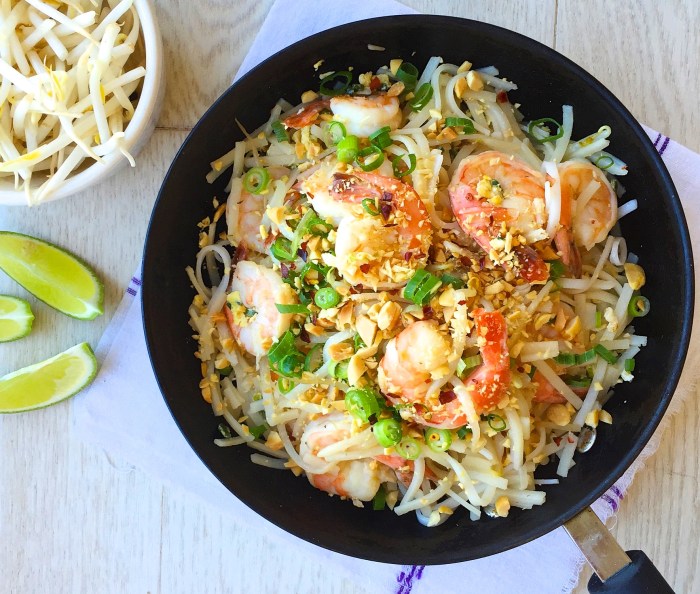
The traditional way of serving shrimp pad thai is on a large, flat platter or in individual bowls. This allows for the noodles to be easily mixed with the sauce and enjoyed. It’s also a visually appealing way to present the dish, highlighting the vibrant colors of the ingredients.
Garnishes and Accompaniments
Garnishes and accompaniments play a crucial role in enhancing the flavor and visual appeal of shrimp pad thai. These additions can be incorporated directly into the dish or served on the side for individual preference. Here is a table showcasing different garnishes and accompaniments that elevate the shrimp pad thai experience:| Garnishes and Accompaniments | Description ||—|—|| Fresh herbs:| Basil, cilantro, mint, and spring onions add a refreshing touch and aromatic depth.
|| Lime wedges:| The tangy juice of lime balances the richness of the dish and adds a bright flavor profile. || Crushed peanuts:| A crunchy texture and nutty flavor complement the noodles and sauce. || Sriracha sauce:| For those who prefer a spicy kick, sriracha sauce can be added to taste.
|| Fish sauce:| A traditional Thai condiment that adds a salty and umami flavor to the dish. || Chilli flakes:| A sprinkle of chilli flakes adds a subtle heat and depth to the dish. || Pickled vegetables:| Pickled carrots, radishes, and onions provide a tangy contrast and textural element.
|
Creative Presentation
Shrimp pad thai can be presented in various creative ways, making it an aesthetically pleasing and Instagram-worthy dish.
1. Nestled Noodles
The noodles can be arranged in a nest-like shape on a platter, with the shrimp placed on top. This presentation showcases the texture of the noodles and the vibrant colors of the ingredients.
2. Spiral Presentation
The noodles can be coiled into a spiral shape on a plate, creating a visually appealing and intricate design. The shrimp can be arranged around the spiral, adding a touch of elegance.
3. Artistic Arrangement
The shrimp pad thai can be arranged in a more artistic way, incorporating different colors and textures. For example, the shrimp can be placed in a circle, with the noodles fanned out around it, creating a beautiful and eye-catching design.
4. Layered Presentation
A layered presentation can be achieved by placing a bed of noodles at the bottom of a bowl, followed by the shrimp, sauce, and garnishes. This presentation allows for the different flavors to mingle and create a more complex taste experience.
5. Individual Portions
Shrimp pad thai can also be served in individual portions, making it a convenient and elegant option for a meal or a party. This can be achieved by using small bowls or ramekins.
Conclusion

Making shrimp pad thai from scratch is surprisingly simple, as we’ve seen. With just a few key ingredients and some basic cooking techniques, you can create a delicious and authentic dish that’s sure to impress your friends and family. Remember, the beauty of pad thai lies in its adaptability.
Feel free to experiment with different ingredients and flavors to create your own unique version.
Encouraging Experimentation
Don’t be afraid to get creative with your pad thai! Whether you’re adding extra vegetables, different types of protein, or experimenting with different sauces, the possibilities are endless. Share your culinary adventures with us! Let us know what unique variations you’ve created and what your favorite combinations are.
We love hearing about your culinary explorations and sharing the joy of pad thai with others.

